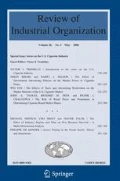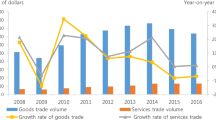Abstract
There is significant debate over the effect of the Interstate Commerce Act (ICA) on the cost of rail transport to shippers. Taking price differences across locations as proxy for transport costs, we use data on wheat prices before and after the implementation of the ICA to see if the Act led to smaller differences in wheat prices across American cities relative to a control group of European cities. We find that the ICA had no effect on US transport costs; however, it reduced their volatility substantially. This evidence supports the view that the ICA helped stabilize cartel prices after a period of significant price wars.


Similar content being viewed by others
Notes
See Porter (1983) for an interesting theoretical and empirical analysis that confirms switches in industry behavior from cartel pricing to non-cooperative oligopoly pricing in the years immediately preceding the ICA.
See Aitchison (1937) for a detailed description of the ICA.
He also notes a memo from an ICC Commissioner, Aldace F. Walker, who resigned after his first 2 years to take another position, indicating the Commissioner’s opinion that the ICC was more effective at maintaining cartel prices than the railroads’ own “pool” prior to the ICA.
Relatedly, the “Wabash decision” in 1886 was a court ruling that prohibited states from regulating railroads on interstate transport, setting the stage for the passage of the ICA to establish federal regulation of interstate transport. This is viewed by many as a substantial gain for railroad interests as well, because it eliminated many state regulations that had become quite severe in some circumstances.
Spann and Erickson (1970) estimate from their limited survey that rates fell 15–30 % on short-haul routes and went up only slightly on long-haul routes. MacAvoy (1965) provides a more detailed, and complicated, picture about how rates changed. Posting of public rates subsequent to the passage of the ICA appears to have led to the elimination of “special”, discriminatory rates for certain customers, tending to keep rates higher. Yet, even within the first year, there were examples of competitive rate decreases on the longer haul routes.
Dennis (1999) is an example of the estimation of the impact of railroad deregulation on volatility of transport costs in another (more modern) setting: steam coal rates after the 1980 deregulation.
We are unable to find data for only wheat shipments for this general period, even from Interstate Commerce Commission reports, but others (e.g., Fogel 1964) note that wheat and corn were the two main grain shipments at the time.
See Table 2 in Jacks (2006) and related online data appendices at http://www.sfu.ca/~djacks/data/publications/publications.html for further details on data sources and measurement.
Table 1 Summary statistics A difference-in-differences specification simply estimates the relative effect of a “treatment” on a treated group vis-à-vis a non-treated (or control) group with respect to a particular outcome (here, wheat transport costs). This relative difference-in-difference effect is typically estimated by an interaction of a variable that indicates a “treated” observation and a variable indicating the period of treatment. This is exactly how our ICA \(_{ijt}\) variable is defined in Eq. (6), where the “treatment” is the ICA and our treatment group is the US city-pairs in our sample. See Meyer (1995) and Angrist and Pischke (2008) for general discussion of the methodology.
Jacks reports that results are robust to weighting by other related measures, such as the standard error or p value of the estimated transport costs. Saxonhouse (1976) provides the econometric theory for the application of such weights when using a generated dependent variable.
The continuous variables that we express in log form are the transport cost, distance, distance squared, rail \(\times \) distance, exchange rate volatility, and ad valorem tariff.
Our first difference model imposes the constraint that the slope coefficients are common across US and non-US city pairs. In unreported results, we have experimented with a more flexible model specification that also includes interaction terms between the regression variables and the indicator for US domestic city-pairs. However, the ICA estimate remains insignificant.
Table 3 First difference estimation In unreported results, we also investigate the effect of ICA on the rate of wheat price adjustment (i.e., \(\rho \) parameters in the system of Eqs. 3) and (4). Data on the speed of adjustment is available from the same source: Jacks (2005, 2006). A high degree of market integration is associated with a rapid convergence in wheat prices within a city-pair. While we are agnostic about the potential impact of ICA on the speed of price adjustment, our estimation results suggest that the new regulatory regime introduced by the ICA had no direct effect on the rate of price convergence.
In a related specification, we replace the continuous distance measure with an indicator variable for short- versus long-haul routes. City–pairs that are located within a 500-mile radius are classified as short-distance routes; the remaining city-pairs are in the category of long-haul routes. In unreported estimations, we find similar results: The ICA has no significant effect on transport costs between proximate cities, but leads to a fall in transport costs of 17 % (relative to short-haul routes) on long-distance routes.
We have also experimented with city-specific (rather than city-pair) ICA effects in order to see whether the insignificant effect of the ICA is due to opposing effects in monopolized versus competitive markets. The city-specific ICA coefficients turn out to be insignificant in most cases, except for a positive effect for Ithaca and negative effect for San Francisco.
We have also examined the change in estimates when we exclude all of the city–pairs that involve Ithaca, which is a considerably smaller market compared to the rest of the sample cities. We found no qualitative difference between those estimates and the main results that are reported in this paper.
References
Aitchison, C. B. (1937). The evolution of the Interstate Commerce Act: 1887–1937. George Washington Law Review, 5(3), 289–403.
Angrist, J. D., & Pischke, J.-S. (2008). Mostly harmless econometrics: An empiricist’s companion. Princeton, NJ: Princeton University Press.
Balke, N. S., & Fomby, T. B. (1997). Threshold cointegration. International Economic Review, 38(3), 627–645.
Benson, L. (1955). Merchants, farmers, and railroads. Cambridge, MA: Harvard University Press.
Binder, J. J. (1985). Measuring the effects of regulation with stock price data. RAND Journal of Economics, 16(2), 167–183.
Buck, S. (1921). The Agrarian Crusade. New Haven, CT: Yale University Press.
Canjels, E., Prakash-Canjels, G., & Taylor, A. M. (2004). Measuring market integration: Foreign exchange arbitrage and the gold standard. Review of Economics and Statistics, 86(4), 868–882.
Dennis, S. M. (1999). Using spatial equilibrium models to analyze transportation rates: An application to steam coal in the United States. Transportation Research Part E: Logistics and Transportation Review, 35(3), 145–154.
Donaldson, D. (Forthcoming). Railroads of the Raj: Estimating the impact of transportation infrastructure. American Economic Review.
Ejrnaes, M., & Persson, K. G. (2000). Market integration and transport costs in France 1825–1903. Explorations in Economic History, 37(2), 149–173.
Fogel, Robert W. (1964). Railroads and American economic growth: Essays in econometric history (Vol. 296). Baltimore, MD: Johns Hopkins Press.
Gilligan, T. W., Marshall, W. J., & Weingast, B. R. (1990). The economic incidence of the Interstate Commerce Act of 1987: A theoretical and empirical analysis of the short-haul pricing constraint. RAND Journal of Economics, 21(2), 189–210.
Goodwin, B. K., & Grennes, T. J. (1998). Tsarist Russia and the world wheat market. Explorations in Economic History, 35(4), 405–430.
Hansen, B. E. (1997). Inference in TAR models. Studies in Nonlinear Dynamics and Econometrics, 2(1), 1–14.
Hansen, B. E., & Seo, B. (2002). Testing for two-regime threshold cointegration in vector error correction models. Journal of Econometrics, 110(2), 293–318.
Jacks, D. S. (2005). Intra- and international commodity market integration in the Atlantic economy, 1800–1913. Explorations in Economic History, 42(3), 381–413.
Jacks, D. S. (2006). What drove 19th century commodity market integration? Explorations in Economic History, 43(3), 383–412.
Kolko, G. (1965). Rails and regulation, 1877–1918. Princeton, NJ: Princeton University Press.
MacAvoy, P. W. (1965). The economic effects of regulation: The trunk-line railroad cartels and the interstate commerce commission before 1900. Cambridge, MA: The MIT Press.
Meyer, B. D. (1995). Natural and quasi-natural experiments in economics. Journal of Business and Economic Statistics, 13(2), 151–161.
Miller, G. (1971). Railroads and the Granger laws. Madison, WI: University of Wisconsin Press.
O’Rourke, K. H., Taylor, A. M., & Williamson, J. G. (1996). Factor price convergence in the late nineteenth century. International Economic Review, 37(3), 499–530.
Persson, K. G. (2004). Mind the gap! Transport costs and price convergence in the nineteenth century Atlantic economy. European Review of Economic History, 8(2), 125–148.
Porter, R. H. (1983). A study of cartel stability: The Joint Executive Committee, 1880–1886. Bell Journal of Economics, 14(2), 301–314.
Prager, R. A. (1989). Using stock price data to measure the effects of regulation: The Interstate Commerce Act and the railroad industry. RAND Journal of Economics, 20(2), 280–290.
Ripley, W. Z. (1906). The trunkline rate system: A distance tariff. Quarterly Journal of Economics, 20(2), 183–210.
Saxonhouse, G. R. (1976). Estimated parameters as dependent variables. American Economic Review, 66(1), 178–183.
Shiue, C. H., & Keller, W. (2007). Markets in China and Europe on the eve of the industrial revolution. American Economic Review, 97(4), 1189–1216.
Spann, R. M., & Erickson, E. W. (1970). The economics of railroading: The beginning of cartelization and regulation. Bell Journal of Economics and Management Science, 1(2), 227–244.
Ulen, T. S. (1980). The market for regulation: The ICC from 1887 to 1920. American Economic Review, 70(2), 306–310.
Zerbe, R. (1980). The costs and benefits of early regulation of the railroads. The Bell Journal of Economics, 11(1), 343–350.
Acknowledgments
We thank David Jacks for sharing his data with us, and Mitch Johnson for excellent research assistance. We also thank Lawrence White, Wes Wilson and anonymous referees for their comments.
Author information
Authors and Affiliations
Corresponding author
Appendix
Rights and permissions
About this article
Cite this article
Blonigen, B.A., Cristea, A. The Effects of the Interstate Commerce Act on Transport Costs: Evidence from Wheat Prices. Rev Ind Organ 43, 41–62 (2013). https://doi.org/10.1007/s11151-013-9394-8
Published:
Issue Date:
DOI: https://doi.org/10.1007/s11151-013-9394-8




